1.
FAL組件
1.1
什么是FAL
FAL (Flash Abstraction Layer) Flash 抽象層,是對 Flash 及基于 Flash 的分區(qū)進行管理、操作的抽象層,對上層統(tǒng)一了 Flash 及 分區(qū)操作的 API (框架圖如下所示),并具有以下特性:
支持靜態(tài)可配置的分區(qū)表,并可關(guān)聯(lián)多個 Flash 設(shè)備;
分區(qū)表支持 自動裝載 。避免在多固件項目,分區(qū)表被多次定義的問題;
代碼精簡,對操作系統(tǒng) 無依賴 ,可運行于裸機平臺,比如對資源有一定要求的 Bootloader;
統(tǒng)一的操作接口。保證了文件系統(tǒng)、OTA、NVM(例如:EasyFlash https://github.com/armink-rtt-pkgs/EasyFlash) 等對 Flash 有一定依賴的組件,底層 Flash 驅(qū)動的可重用性;
自帶基于 Finsh/MSH 的測試命令,可以通過 Shell 按字節(jié)尋址的方式操作(讀寫擦) Flash 或分區(qū),方便開發(fā)者進行調(diào)試、測試;

通過上圖我們也可以清晰明了了,看到,F(xiàn)AL抽象層向下可以通過Flash硬件進行統(tǒng)一管理,當然也可以使用SFUD框架(串行Flash通用驅(qū)動庫,這部分RT-Thread已完成官方框架的移植同時提供多個應(yīng)用歷程),而對上也可以使用如DFS、NVM提供的Flash硬件統(tǒng)一訪問接口,方便用戶更加直接方便對底層Flash硬件的訪問操作。
注:非易失性存儲器 (NVM):在芯片電源關(guān)閉期間保存存儲在其中的數(shù)據(jù)。因此,它被用于沒有磁盤的便攜式設(shè)備中的內(nèi)存,以及用于可移動存儲卡等用途。主要類型有:非易失性半導(dǎo)體存儲器 (Non-volatile semiconductor memory, NVSM) 將數(shù)據(jù)存儲在浮柵存儲單元中,每個單元都由一個浮柵(floating-gate) MOSFET 組成。
關(guān)于存儲,可以用一張圖來解釋:
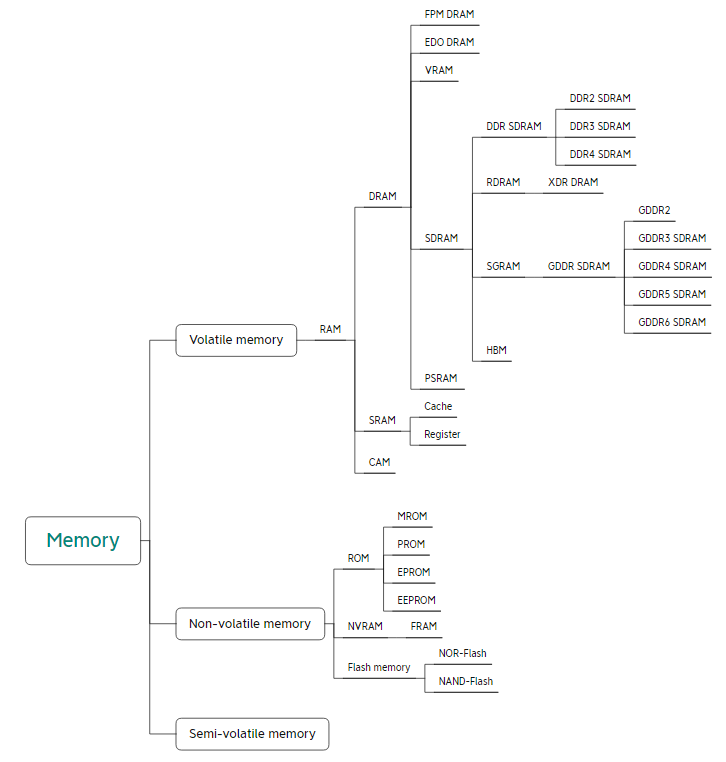
來源:ROM、RAM、FLASH、NVM......一文搞定
1.2
使用ENV配置FAL
在RT-Thread v4.1.0之前,F(xiàn)AL是作為軟件包形式對用戶開放使用的,而v4.1.0之后,F(xiàn)AL被RT-Thread官方重新定義為RTT組件的一部分,這樣也能更加方便用戶的開發(fā)。
我們下面正式講解FAL組件的使用:
首先打開ENV工具,根據(jù)以下路徑打開FAL使能 RT-Thread Components->[*]FAL: flash abstraction layer,由于我們后面會用到SFUD,所以這里把 FAL uses SFUD drivers 一并使能,并修改FAL設(shè)備名稱為 W25Q128.
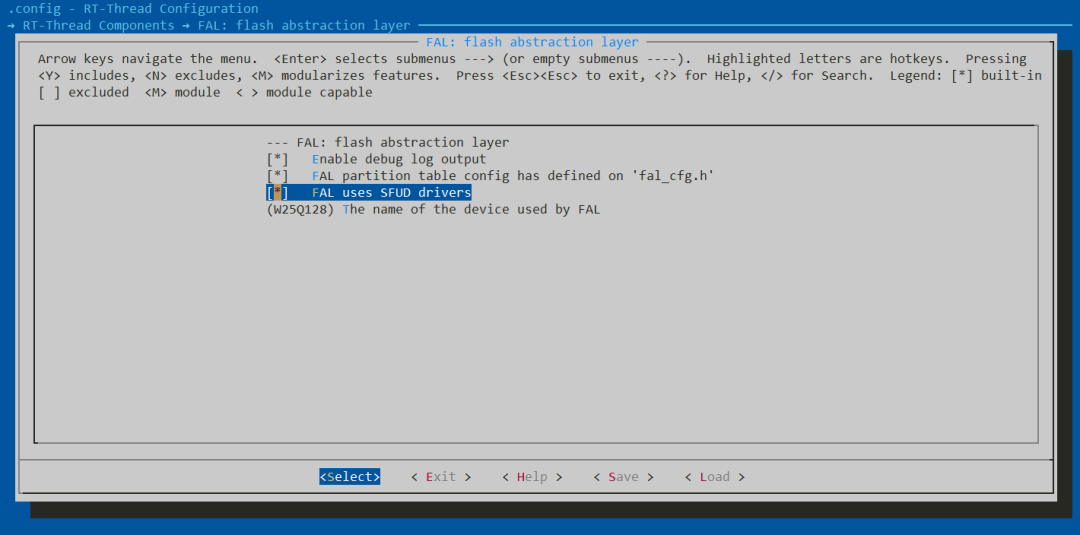
完成上述操作后保存退出,并使用 scons --target=mdk5 重新生成MDK5文件并打開
1.3
FAL SFUD 移植
為了提供示例,我們選用W25Q128 spi flash作為測試模塊,并且使用SFUD框架對spi flash設(shè)備進行管理和驅(qū)動。
由于目前RT-Thread的SFUD已經(jīng)對W25Q128完成支持,根據(jù)官方的使用手冊,我們僅需編寫fal_cfg.h文件完成對FAL_FLASH_DEV_TABLE及FAL_PART_TABLE的定義即可。文件存放路徑:.\rt-thread\bsp\lpc55sxx\lpc55s69_nxp_evk\board\ports\fal_cfg.h
// fal.cfg.h
/* * Copyright (c) 2006-2023, RT-Thread Development Team * * SPDX-License-Identifier: Apache-2.0 * * Change Logs: * Date Author Notes * 2023-04-21 Wangyuqiang the first version */#ifndef _FAL_CFG_H_#define _FAL_CFG_H_
#include #include
#ifndef FAL_USING_NOR_FLASH_DEV_NAME#define NOR_FLASH_DEV_NAME "norflash0"#else#define NOR_FLASH_DEV_NAME FAL_USING_NOR_FLASH_DEV_NAME#endif
/* Flash device Configuration */
extern struct fal_flash_dev nor_flash0;
/* flash device table */
#define FAL_FLASH_DEV_TABLE \{ \ &nor_flash0, \}
/* Partition Configuration */
#ifdef FAL_PART_HAS_TABLE_CFG
/* partition table */
#define FAL_PART_TABLE \{ \ {FAL_PART_MAGIC_WROD, "easyflash", NOR_FLASH_DEV_NAME, 0, 512 * 1024, 0}, \ {FAL_PART_MAGIC_WROD, "download", NOR_FLASH_DEV_NAME, 512 * 1024, 1024 * 1024, 0}, \ {FAL_PART_MAGIC_WROD, "wifi_image", NOR_FLASH_DEV_NAME, (512 + 1024) * 1024, 512 * 1024, 0}, \ {FAL_PART_MAGIC_WROD, "font", NOR_FLASH_DEV_NAME, (512 + 1024 + 512) * 1024, 7 * 1024 * 1024, 0}, \ {FAL_PART_MAGIC_WROD, "filesystem", NOR_FLASH_DEV_NAME, (512 + 1024 + 512 + 7 * 1024) * 1024, 7 * 1024 * 1024, 0}, \}#endif /* FAL_PART_HAS_TABLE_CFG */
#endif /* _FAL_CFG_H_ */
此時編譯的話是找不到該頭文件的,需要我們在Keil中設(shè)置:
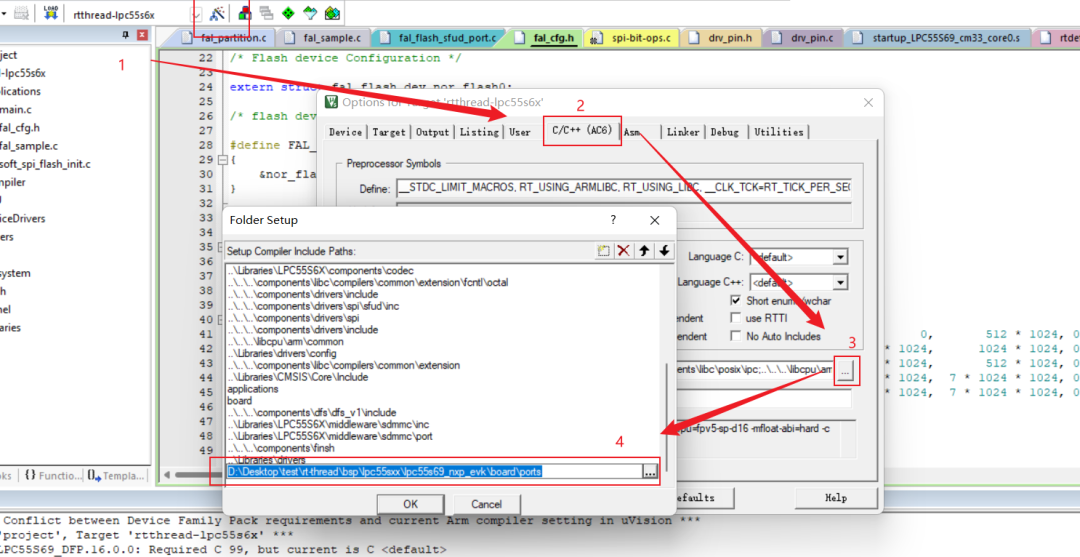
在RTT FAL組件中的SFUD提供的fal_flash_dev對象默認的nor_flash0參數(shù)中,flash大小默認為8M,而W25Q128最大最16M,我們可以選擇在 .\rt-thread\components\fal\samples\porting\fal_flash_sfud_port.c文件中對struct fal_flash_dev nor_flash0 進行修改:
struct fal_flash_dev nor_flash0 ={ .name = FAL_USING_NOR_FLASH_DEV_NAME, .addr = 0, .len = 16 * 1024 * 1024, .blk_size = 4096, .ops = {init, read, write, erase}, .write_gran = 1};
當然也可以選擇不進行修改,根據(jù)大佬的原話就是因為在調(diào)用初始化接口函數(shù)init后,會從flash設(shè)備讀取正確的參數(shù)更新到nor_flash0表項中,我們在使用FAL組件前都需要調(diào)用FAL初始化函數(shù)fal_init,其內(nèi)調(diào)用flash設(shè)備初始化函數(shù)fal_flash_init,最后會調(diào)用注冊到fal_flash_dev設(shè)備表項中的初始化函數(shù)device_table[i]->ops.init,所以nor_flash0表項參數(shù)會在FAL初始化時被更新。
同時我們需要開啟SFUD框架支持,打開ENV工具,由于SFUD的使用需要指定一個spi設(shè)備,這里我選擇使用最近移植好的軟件spi,路徑Hardware Drivers Config->On-chip Peripheral Drivers->[*] Enable soft SPI BUS-> [*] Enable soft SPI1 BUS (software simulation),這里我的測試開發(fā)板是恩智浦的LPC55S69-EVK,并且這款bsp的軟件模擬spi由我本人對接,關(guān)于這部分的軟件spi引腳定義可以選用默認即可,當然也可以使用自定義引腳,記住不要與其他引腳產(chǎn)生沖突。
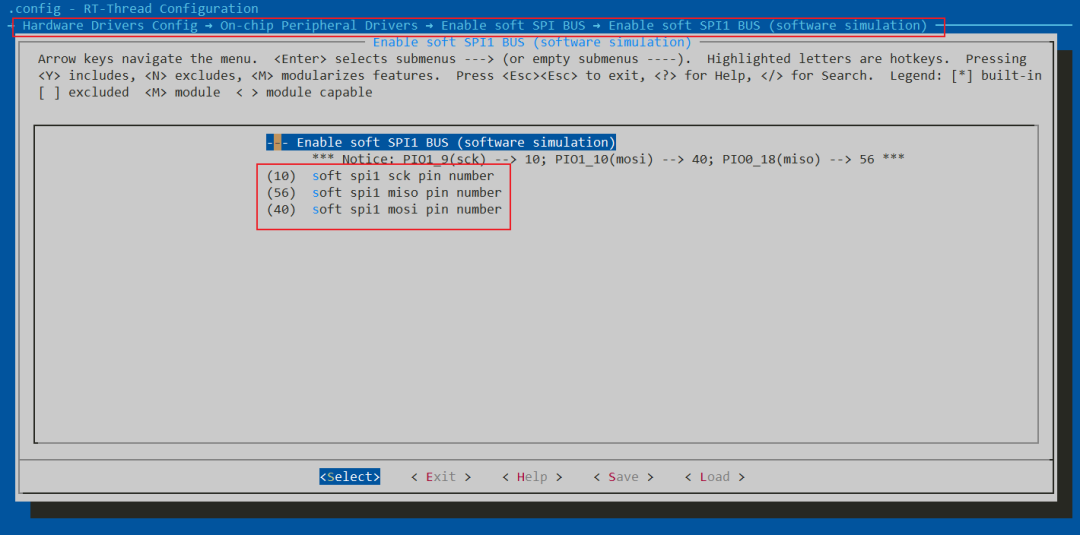
此時我們回到ENV主界面,進入RT-Thread Components->Device Drivers->Using Serial Flash Universal Driver,此時我們才可以看到SFUD選項出現(xiàn)(如果沒有使能spi是沒法看到的),使能后保持默認即可
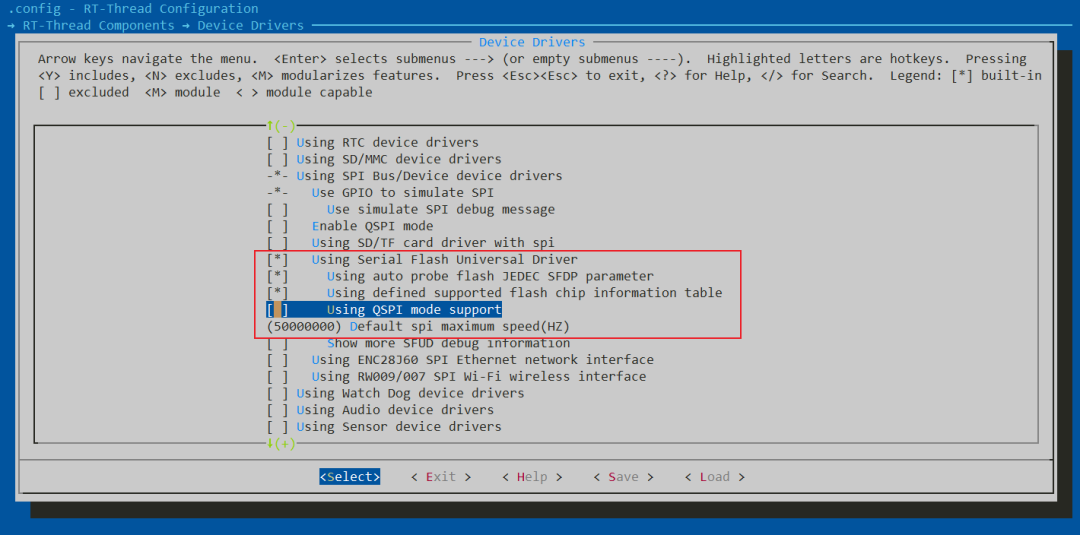
到這里,ENV的配置暫時告一段落!
1.4
FAL SFUD 測試用例
為了驗證W25Q128及軟件模擬spi在SFUD框架上是否能夠成功運行,我們在.\rt-thread\bsp\lpc55sxx\lpc55s69_nxp_evk\board\ports\下新建一個soft_spi_flash_init.c文件,代碼如下
/* * Copyright (c) 2006-2023, RT-Thread Development Team * * SPDX-License-Identifier: Apache-2.0 * * Change Logs: * Date Author Notes * 2023-04-21 Wangyuqiang the first version */
#include #include "spi_flash.h"#include "spi_flash_sfud.h"#include "drv_soft_spi.h"#include "drv_pin.h"#include "rtconfig.h"
#define cs_pin GET_PINS(1,9)
static int rt_soft_spi_flash_init(void){ int result = -1;
result = rt_hw_softspi_device_attach("sspi1", "sspi10", cs_pin); rt_kprintf("value is %d\n",result); if(result == RT_EOK) { rt_kprintf("rt_hw_softspi_device_attach successful!\n"); }
if (RT_NULL == rt_sfud_flash_probe("W25Q128", "sspi10")) { return -RT_ERROR; }
return RT_EOK;}INIT_COMPONENT_EXPORT(rt_soft_spi_flash_init);
這里我們需要指定一個片選引腳,我暫時使用了sspi2的SCK引腳作為片選,這里注意不要同時打開sspi1和sspi2,后續(xù)我會專門上傳一個通用GPIO作為片選引腳,到時候就不會產(chǎn)生問題了。然后軟件spi設(shè)備的掛載使用的是sspi1 bus及sspi10 device,并且掛載flash設(shè)備到sspi10。
另外我們在.\rt-thread\bsp\lpc55sxx\lpc55s69_nxp_evk\board\ports\下新建fal_sample.c文件,并編寫測試代碼:
//fal_sample.c
/* * Copyright (c) 2006-2023, RT-Thread Development Team * * SPDX-License-Identifier: Apache-2.0 * * Change Logs: * Date Author Notes * 2023-04-21 Wangyuqiang the first version */ #include "rtthread.h"#include "rtdevice.h"#include "board.h"#include "fal.h"
#define BUF_SIZE 1024
static int fal_test(const char *partiton_name){ int ret; int i, j, len; uint8_t buf[BUF_SIZE]; const struct fal_flash_dev *flash_dev = RT_NULL; const struct fal_partition *partition = RT_NULL;
if (!partiton_name) { rt_kprintf("Input param partition name is null!\n"); return -1; }
partition = fal_partition_find(partiton_name); if (partition == RT_NULL) { rt_kprintf("Find partition (%s) failed!\n", partiton_name); ret = -1; return ret; }
flash_dev = fal_flash_device_find(partition->flash_name); if (flash_dev == RT_NULL) { rt_kprintf("Find flash device (%s) failed!\n", partition->flash_name); ret = -1; return ret; }
rt_kprintf("Flash device : %s " "Flash size : %dK \n" "Partition : %s " "Partition size: %dK\n", partition->flash_name, flash_dev->len/1024, partition->name, partition->len/1024);
/* erase all partition */ ret = fal_partition_erase_all(partition); if (ret < 0) { rt_kprintf("Partition (%s) erase failed!\n", partition->name); ret = -1; return ret; } rt_kprintf("Erase (%s) partition finish!\n", partiton_name);
/* read the specified partition and check data */ for (i = 0; i < partition->len;) { rt_memset(buf, 0x00, BUF_SIZE);
len = (partition->len - i) > BUF_SIZE ? BUF_SIZE : (partition->len - i);
ret = fal_partition_read(partition, i, buf, len); if (ret < 0) { rt_kprintf("Partition (%s) read failed!\n", partition->name); ret = -1; return ret; }
for(j = 0; j < len; j++) { if (buf[j] != 0xFF) { rt_kprintf("The erase operation did not really succeed!\n"); ret = -1; return ret; } } i += len; }
/* write 0x00 to the specified partition */ for (i = 0; i < partition->len;) { rt_memset(buf, 0x00, BUF_SIZE);
len = (partition->len - i) > BUF_SIZE ? BUF_SIZE : (partition->len - i);
ret = fal_partition_write(partition, i, buf, len); if (ret < 0) { rt_kprintf("Partition (%s) write failed!\n", partition->name); ret = -1; return ret; }
i += len; } rt_kprintf("Write (%s) partition finish! Write size %d(%dK).\n", partiton_name, i, i/1024);
/* read the specified partition and check data */ for (i = 0; i < partition->len;) { rt_memset(buf, 0xFF, BUF_SIZE);
len = (partition->len - i) > BUF_SIZE ? BUF_SIZE : (partition->len - i);
ret = fal_partition_read(partition, i, buf, len); if (ret < 0) { rt_kprintf("Partition (%s) read failed!\n", partition->name); ret = -1; return ret; }
for(j = 0; j < len; j++) { if (buf[j] != 0x00) { rt_kprintf("The write operation did not really succeed!\n"); ret = -1; return ret; } }
i += len; }
ret = 0; return ret;}
static void fal_sample(void){ /* 1- init */ fal_init();
if (fal_test("font") == 0) { rt_kprintf("Fal partition (%s) test success!\n", "font"); } else { rt_kprintf("Fal partition (%s) test failed!\n", "font"); }
if (fal_test("download") == 0) { rt_kprintf("Fal partition (%s) test success!\n", "download"); } else { rt_kprintf("Fal partition (%s) test failed!\n", "download"); }}MSH_CMD_EXPORT(fal_sample, fal sample);
1.5
測試結(jié)果
到這里就可以進行編譯下載了,成功后的截圖如下:
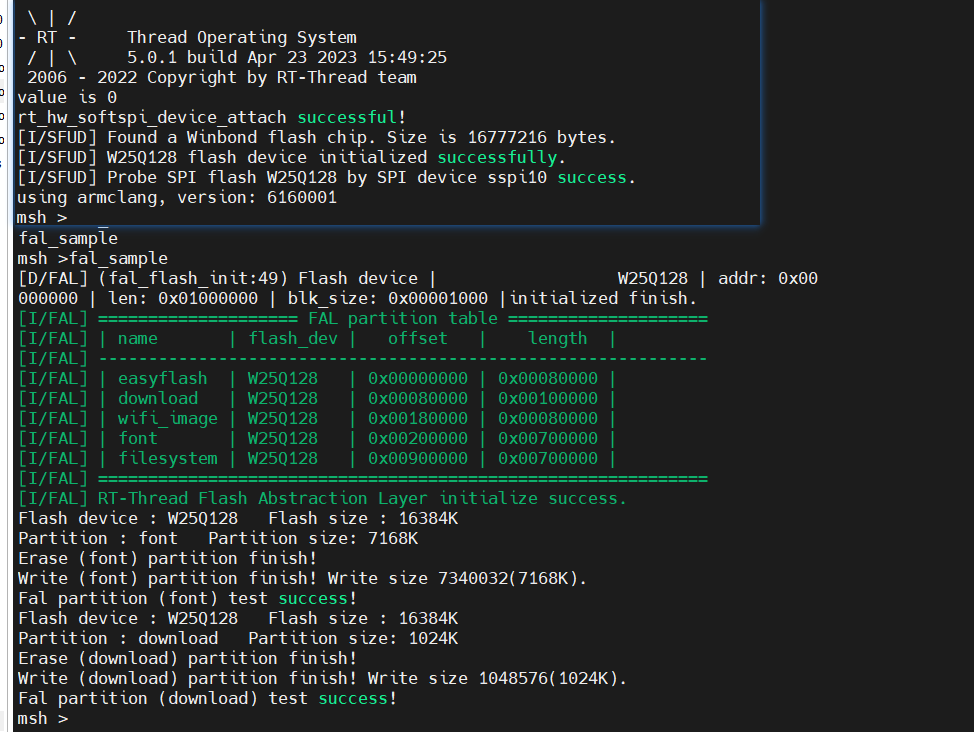
2.
DFS文件系統(tǒng)
2.1
什么是DFS
DFS 是 RT-Thread 提供的虛擬文件系統(tǒng)組件,全稱為 Device File System,即設(shè)備虛擬文件系統(tǒng),文件系統(tǒng)的名稱使用類似 UNIX 文件、文件夾的風(fēng)格,目錄結(jié)構(gòu)如下圖所示:
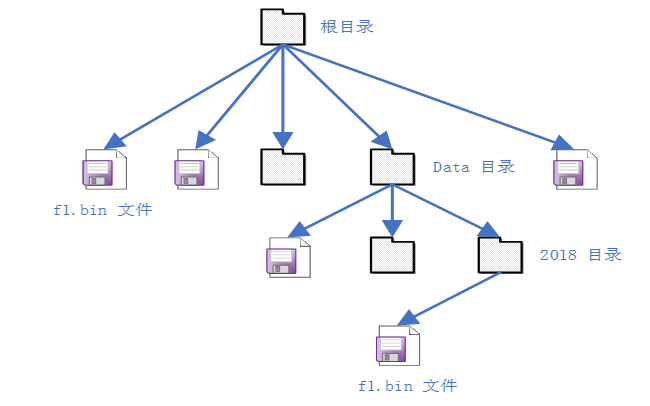
在 RT-Thread DFS 中,文件系統(tǒng)有統(tǒng)一的根目錄,使用 / 來表示。而在根目錄下的 f1.bin 文件則使用 /f1.bin來表示,2018 目錄下的 f1.bin 目錄則使用 /data/2018/f1.bin 來表示。即目錄的分割符號是 /,這與 UNIX/Linux 完全相同,與 Windows 則不相同(Windows 操作系統(tǒng)上使用 \ 來作為目錄的分割符)。
2.2
DFS架構(gòu)
RT-Thread DFS 組件的主要功能特點有:
為應(yīng)用程序提供統(tǒng)一的 POSIX 文件和目錄操作接口:read、write、poll/select 等。
支持多種類型的文件系統(tǒng),如 FatFS、RomFS、DevFS 等,并提供普通文件、設(shè)備文件、網(wǎng)絡(luò)文件描述符的管理。
支持多種類型的存儲設(shè)備,如 SD Card、SPI Flash、Nand Flash 等。
DFS 的層次架構(gòu)如下圖所示,主要分為 POSIX 接口層、虛擬文件系統(tǒng)層和設(shè)備抽象層。
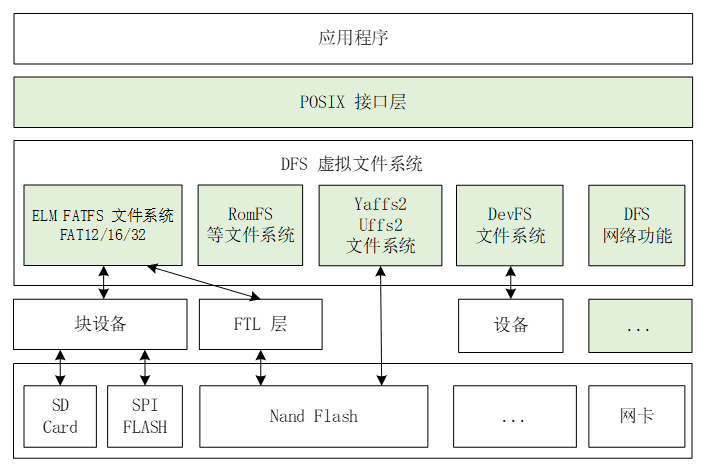
2.3
使用ENV配置DFS
打開ENV,進入路徑RT-Thread Components → DFS: device virtual file system,使能[*] DFS: device virtual file system
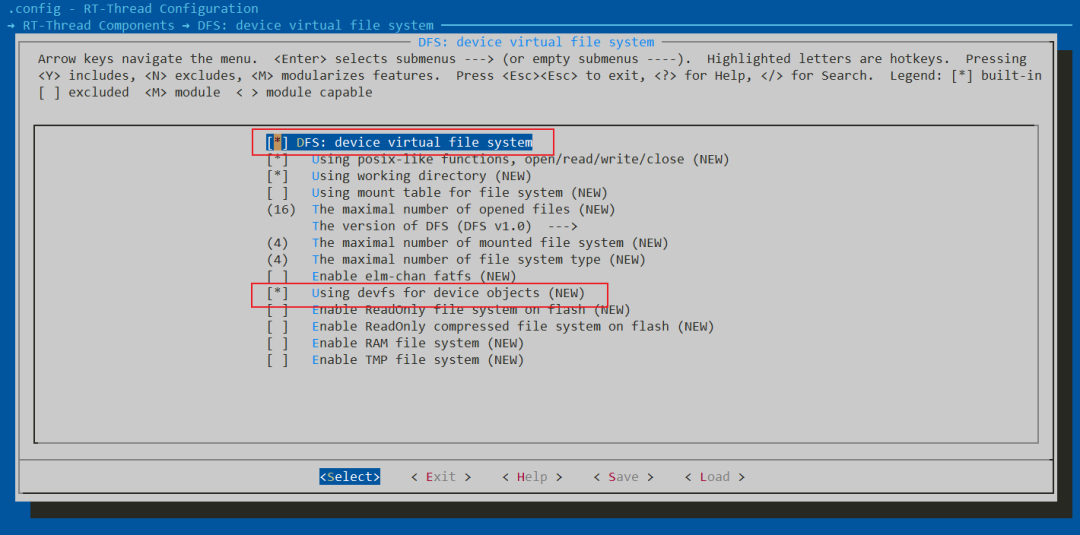
由于DFS使用的是POSIX接口,而dfs_posix.h已經(jīng)在新版本中被移除了,如果想要兼容老版本,可以在menuconfig中使能RT-Thread Components->[*] Support legacy version for compatibility
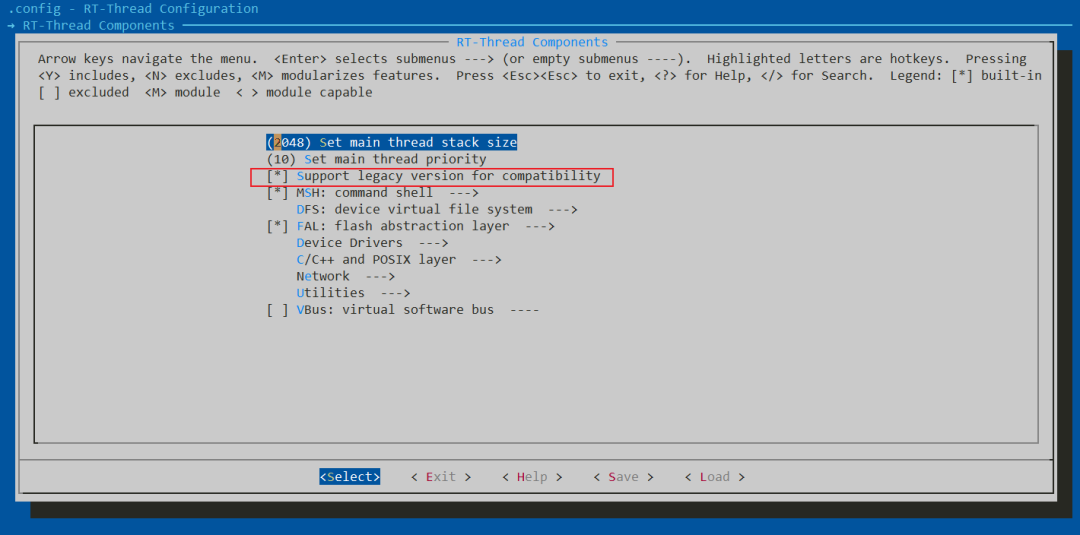
由于elmfat文件系統(tǒng)默認最大扇區(qū)大小為512,但我們使用的flash模塊W25Q128的Flash扇區(qū)大小為4096,為了將elmfat文件系統(tǒng)掛載到W25Q128上,這里的Maximum sector size需要和W25Q128扇區(qū)大小保持一致,修改為4096,路徑:RT-Thread Components → DFS: device virtual file system → [*] Enable elm-chan fatfs / elm-chan's FatFs, Generic FAT Filesystem Module
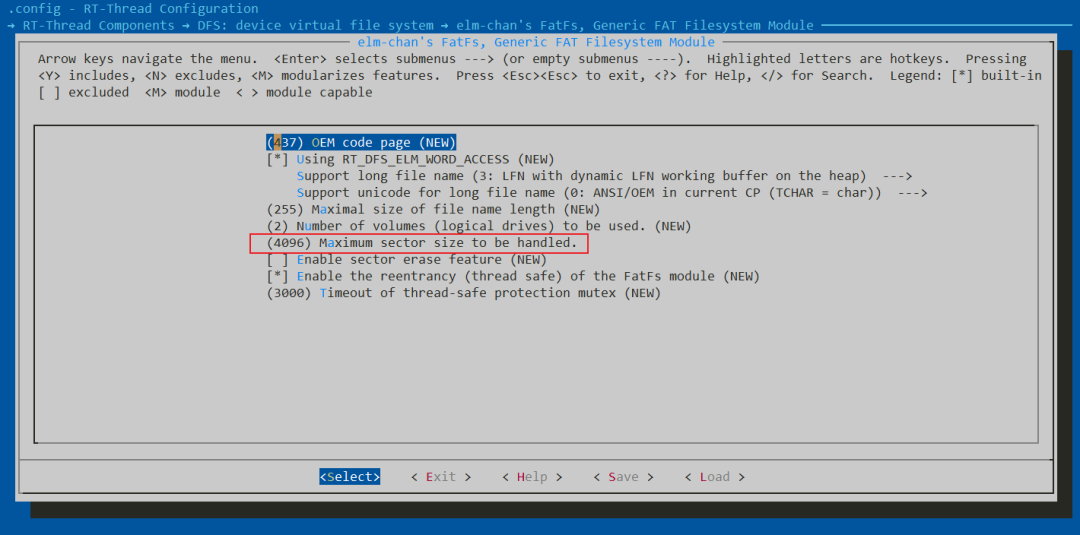
保存退出后使用scons --target=mdk5生成MDK5工程。
2.4
DFS掛載到FAL分區(qū)測試
這里增加FAL flash抽象層,我們將elmfat文件系統(tǒng)掛載到W25Q128 flash設(shè)備的filesystem分區(qū)上,由于FAL管理的filesystem分區(qū)不是塊設(shè)備,需要先使用FAL分區(qū)轉(zhuǎn)BLK設(shè)備接口函數(shù)將filesystem分區(qū)轉(zhuǎn)換為塊設(shè)備,然后再將DFS elmfat文件系統(tǒng)掛載到filesystem塊設(shè)備上。
我們接著修改fal_sample.c文件,修改后代碼:
/* * Copyright (c) 2006-2023, RT-Thread Development Team * * SPDX-License-Identifier: Apache-2.0 * * Change Logs: * Date Author Notes * 2023-04-21 Wangyuqiang the first version */ #include "rtthread.h"#include "rtdevice.h"#include "board.h"#include "fal.h"
#include
#define FS_PARTITION_NAME "filesystem"
#define BUF_SIZE 1024
static int fal_test(const char *partiton_name){ int ret; int i, j, len; uint8_t buf[BUF_SIZE]; const struct fal_flash_dev *flash_dev = RT_NULL; const struct fal_partition *partition = RT_NULL;
if (!partiton_name) { rt_kprintf("Input param partition name is null!\n"); return -1; }
partition = fal_partition_find(partiton_name); if (partition == RT_NULL) { rt_kprintf("Find partition (%s) failed!\n", partiton_name); ret = -1; return ret; }
flash_dev = fal_flash_device_find(partition->flash_name); if (flash_dev == RT_NULL) { rt_kprintf("Find flash device (%s) failed!\n", partition->flash_name); ret = -1; return ret; }
rt_kprintf("Flash device : %s " "Flash size : %dK \n" "Partition : %s " "Partition size: %dK\n", partition->flash_name, flash_dev->len/1024, partition->name, partition->len/1024);
/* erase all partition */ ret = fal_partition_erase_all(partition); if (ret < 0) { rt_kprintf("Partition (%s) erase failed!\n", partition->name); ret = -1; return ret; } rt_kprintf("Erase (%s) partition finish!\n", partiton_name);
/* read the specified partition and check data */ for (i = 0; i < partition->len;) { rt_memset(buf, 0x00, BUF_SIZE);
len = (partition->len - i) > BUF_SIZE ? BUF_SIZE : (partition->len - i);
ret = fal_partition_read(partition, i, buf, len); if (ret < 0) { rt_kprintf("Partition (%s) read failed!\n", partition->name); ret = -1; return ret; }
for(j = 0; j < len; j++) { if (buf[j] != 0xFF) { rt_kprintf("The erase operation did not really succeed!\n"); ret = -1; return ret; } } i += len; }
/* write 0x00 to the specified partition */ for (i = 0; i < partition->len;) { rt_memset(buf, 0x00, BUF_SIZE);
len = (partition->len - i) > BUF_SIZE ? BUF_SIZE : (partition->len - i);
ret = fal_partition_write(partition, i, buf, len); if (ret < 0) { rt_kprintf("Partition (%s) write failed!\n", partition->name); ret = -1; return ret; }
i += len; } rt_kprintf("Write (%s) partition finish! Write size %d(%dK).\n", partiton_name, i, i/1024);
/* read the specified partition and check data */ for (i = 0; i < partition->len;) { rt_memset(buf, 0xFF, BUF_SIZE);
len = (partition->len - i) > BUF_SIZE ? BUF_SIZE : (partition->len - i);
ret = fal_partition_read(partition, i, buf, len); if (ret < 0) { rt_kprintf("Partition (%s) read failed!\n", partition->name); ret = -1; return ret; }
for(j = 0; j < len; j++) { if (buf[j] != 0x00) { rt_kprintf("The write operation did not really succeed!\n"); ret = -1; return ret; } }
i += len; }
ret = 0; return ret;}
static void fal_sample(void){ /* 1- init */ fal_init();
if (fal_test("font") == 0) { rt_kprintf("Fal partition (%s) test success!\n", "font"); } else { rt_kprintf("Fal partition (%s) test failed!\n", "font"); }
if (fal_test("download") == 0) { rt_kprintf("Fal partition (%s) test success!\n", "download"); } else { rt_kprintf("Fal partition (%s) test failed!\n", "download"); }}MSH_CMD_EXPORT(fal_sample, fal sample);
static void fal_elmfat_sample(void){ int fd, size; struct statfs elm_stat; struct fal_blk_device *blk_dev; char str[] = "elmfat mount to W25Q flash.", buf[80];
/* fal init */ fal_init();
/* create block device */ blk_dev = (struct fal_blk_device *)fal_blk_device_create(FS_PARTITION_NAME); if(blk_dev == RT_NULL) rt_kprintf("Can't create a block device on '%s' partition.\n", FS_PARTITION_NAME); else rt_kprintf("Create a block device on the %s partition of flash successful.\n", FS_PARTITION_NAME);
/* make a elmfat format filesystem */ if(dfs_mkfs("elm", FS_PARTITION_NAME) == 0) rt_kprintf("make elmfat filesystem success.\n");
/* mount elmfat file system to FS_PARTITION_NAME */ if(dfs_mount(FS_PARTITION_NAME, "/", "elm", 0, 0) == 0) rt_kprintf("elmfat filesystem mount success.\n");
/* Get elmfat file system statistics */ if(statfs("/", &elm_stat) == 0) rt_kprintf("elmfat filesystem block size: %d, total blocks: %d, free blocks: %d.\n", elm_stat.f_bsize, elm_stat.f_blocks, elm_stat.f_bfree);
if(mkdir("/user", 0x777) == 0) rt_kprintf("make a directory: '/user'.\n");
rt_kprintf("Write string '%s' to /user/test.txt.\n", str);
/* Open the file in create and read-write mode, create the file if it does not exist*/ fd = open("/user/test.txt", O_WRONLY | O_CREAT); if (fd >= 0) { if(write(fd, str, sizeof(str)) == sizeof(str)) rt_kprintf("Write data done.\n");
close(fd); }
/* Open file in read-only mode */ fd = open("/user/test.txt", O_RDONLY); if (fd >= 0) { size = read(fd, buf, sizeof(buf));
close(fd);
if(size == sizeof(str)) rt_kprintf("Read data from file test.txt(size: %d): %s \n", size, buf); }}MSH_CMD_EXPORT_ALIAS(fal_elmfat_sample, fal_elmfat,fal elmfat sample);
2.5
測試結(jié)果
測試結(jié)果如下:
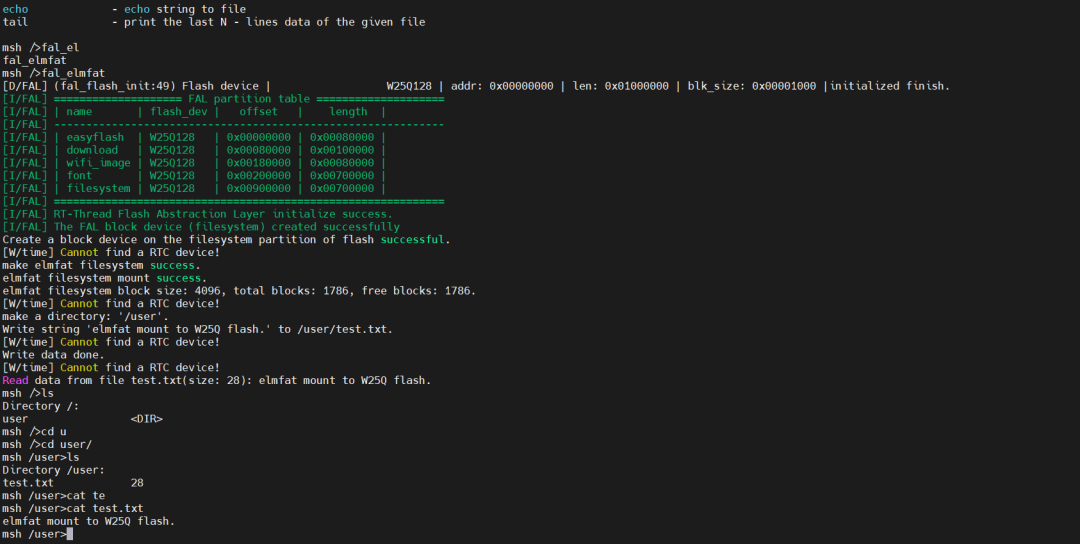
3.
Easyflash移植到FAL分區(qū)
3.1
簡述EasyFlash
關(guān)于EasyFlash的來源我們已經(jīng)講過了,此處不再贅述。EasyFlash是一款開源的輕量級嵌入式Flash存儲器庫,方便開發(fā)者更加輕松的實現(xiàn)基于Flash存儲器的常見應(yīng)用開發(fā)。非常適合智能家居、可穿戴、工控、醫(yī)療、物聯(lián)網(wǎng)等需要斷電存儲功能的產(chǎn)品,資源占用極低,支持各種 MCU 片上存儲器。
EasyFlash不僅能夠?qū)崿F(xiàn)對產(chǎn)品的 設(shè)定參數(shù) 或 運行日志 等信息的掉電保存功能,還封裝了簡潔的 增加、刪除、修改及查詢 方法, 降低了開發(fā)者對產(chǎn)品參數(shù)的處理難度,也保證了產(chǎn)品在后期升級時擁有更好的擴展性。讓Flash變?yōu)镹oSQL(非關(guān)系型數(shù)據(jù)庫)模型的小型鍵值(Key-Value)存儲數(shù)據(jù)庫。
3.2
EasyFlash軟件包使用
打開ENV進入路徑:RT-Thread online packages → tools packages → EasyFlash: Lightweight embedded flash memory library.,選擇軟件包版本為最新版。
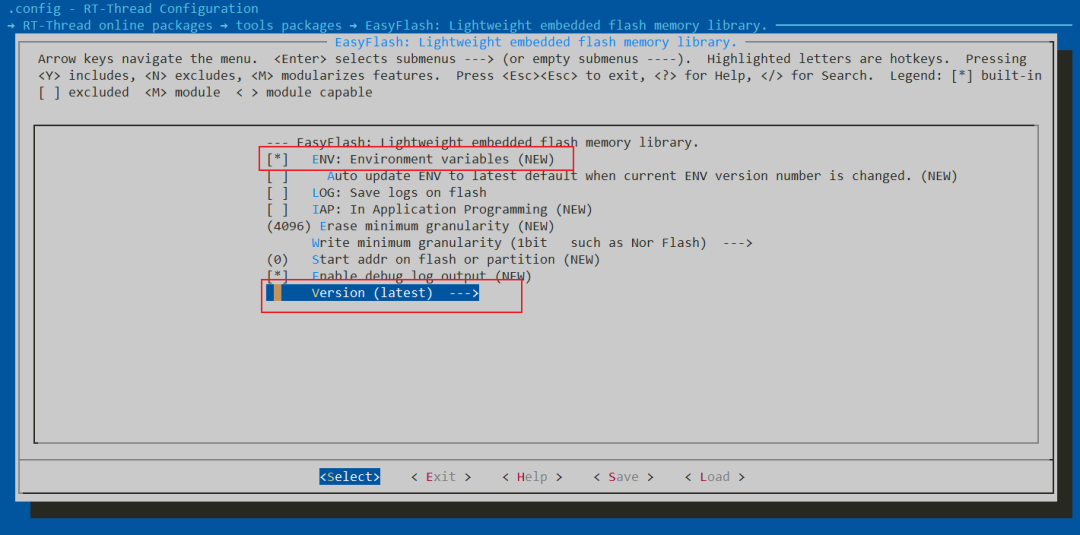
配置后退出ENV,同時使用pkgs --update下載軟件包,然后再使用scons --target=mdk5重新生成MDK5文件
3.3
移植easyflash
下載完easyflash軟件包后,我們復(fù)制.\rt-thread\bsp\lpc55sxx\lpc55s69_nxp_evk\packages\EasyFlash-latest\ports\ef_fal_port.c到目錄.\rt-thread\bsp\lpc55sxx\lpc55s69_nxp_evk\board\ports\easyflash\ef_fal_port.c,雙擊打開該文件,完成以下修改:
// 修改 FAL_EF_PART_NAME 為 easyflash#define FAL_EF_PART_NAME "easyflash"
// 修改環(huán)境變量內(nèi)容為 {"boot_times", "0"},這里我們先只設(shè)置一個開機次數(shù)static const ef_env default_env_set[] = { {"boot_times", "0"},};
3.4
編寫Easyflash測試用例
/* * Copyright (c) 2006-2023, RT-Thread Development Team * * SPDX-License-Identifier: Apache-2.0 * * Change Logs: * Date Author Notes * 2023-04-21 Wangyuqiang the first version */ #include "rtthread.h"#include "rtdevice.h"#include "board.h"#include "fal.h"
#include
#include "easyflash.h"#include
#define FS_PARTITION_NAME "filesystem"
#define BUF_SIZE 1024
static int fal_test(const char *partiton_name){ int ret; int i, j, len; uint8_t buf[BUF_SIZE]; const struct fal_flash_dev *flash_dev = RT_NULL; const struct fal_partition *partition = RT_NULL;
if (!partiton_name) { rt_kprintf("Input param partition name is null!\n"); return -1; }
partition = fal_partition_find(partiton_name); if (partition == RT_NULL) { rt_kprintf("Find partition (%s) failed!\n", partiton_name); ret = -1; return ret; }
flash_dev = fal_flash_device_find(partition->flash_name); if (flash_dev == RT_NULL) { rt_kprintf("Find flash device (%s) failed!\n", partition->flash_name); ret = -1; return ret; }
rt_kprintf("Flash device : %s " "Flash size : %dK \n" "Partition : %s " "Partition size: %dK\n", partition->flash_name, flash_dev->len/1024, partition->name, partition->len/1024);
/* erase all partition */ ret = fal_partition_erase_all(partition); if (ret < 0) { rt_kprintf("Partition (%s) erase failed!\n", partition->name); ret = -1; return ret; } rt_kprintf("Erase (%s) partition finish!\n", partiton_name);
/* read the specified partition and check data */ for (i = 0; i < partition->len;) { rt_memset(buf, 0x00, BUF_SIZE);
len = (partition->len - i) > BUF_SIZE ? BUF_SIZE : (partition->len - i);
ret = fal_partition_read(partition, i, buf, len); if (ret < 0) { rt_kprintf("Partition (%s) read failed!\n", partition->name); ret = -1; return ret; }
for(j = 0; j < len; j++) { if (buf[j] != 0xFF) { rt_kprintf("The erase operation did not really succeed!\n"); ret = -1; return ret; } } i += len; }
/* write 0x00 to the specified partition */ for (i = 0; i < partition->len;) { rt_memset(buf, 0x00, BUF_SIZE);
len = (partition->len - i) > BUF_SIZE ? BUF_SIZE : (partition->len - i);
ret = fal_partition_write(partition, i, buf, len); if (ret < 0) { rt_kprintf("Partition (%s) write failed!\n", partition->name); ret = -1; return ret; }
i += len; } rt_kprintf("Write (%s) partition finish! Write size %d(%dK).\n", partiton_name, i, i/1024);
/* read the specified partition and check data */ for (i = 0; i < partition->len;) { rt_memset(buf, 0xFF, BUF_SIZE);
len = (partition->len - i) > BUF_SIZE ? BUF_SIZE : (partition->len - i);
ret = fal_partition_read(partition, i, buf, len); if (ret < 0) { rt_kprintf("Partition (%s) read failed!\n", partition->name); ret = -1; return ret; }
for(j = 0; j < len; j++) { if (buf[j] != 0x00) { rt_kprintf("The write operation did not really succeed!\n"); ret = -1; return ret; } }
i += len; }
ret = 0; return ret;}
static void fal_sample(void){ /* 1- init */ fal_init();
if (fal_test("font") == 0) { rt_kprintf("Fal partition (%s) test success!\n", "font"); } else { rt_kprintf("Fal partition (%s) test failed!\n", "font"); }
if (fal_test("download") == 0) { rt_kprintf("Fal partition (%s) test success!\n", "download"); } else { rt_kprintf("Fal partition (%s) test failed!\n", "download"); }}MSH_CMD_EXPORT(fal_sample, fal sample);
static void fal_elmfat_sample(void){ int fd, size; struct statfs elm_stat; struct fal_blk_device *blk_dev; char str[] = "elmfat mount to W25Q flash.", buf[80];
/* fal init */ fal_init();
/* create block device */ blk_dev = (struct fal_blk_device *)fal_blk_device_create(FS_PARTITION_NAME); if(blk_dev == RT_NULL) rt_kprintf("Can't create a block device on '%s' partition.\n", FS_PARTITION_NAME); else rt_kprintf("Create a block device on the %s partition of flash successful.\n", FS_PARTITION_NAME);
/* make a elmfat format filesystem */ if(dfs_mkfs("elm", FS_PARTITION_NAME) == 0) rt_kprintf("make elmfat filesystem success.\n");
/* mount elmfat file system to FS_PARTITION_NAME */ if(dfs_mount(FS_PARTITION_NAME, "/", "elm", 0, 0) == 0) rt_kprintf("elmfat filesystem mount success.\n");
/* Get elmfat file system statistics */ if(statfs("/", &elm_stat) == 0) rt_kprintf("elmfat filesystem block size: %d, total blocks: %d, free blocks: %d.\n", elm_stat.f_bsize, elm_stat.f_blocks, elm_stat.f_bfree);
if(mkdir("/user", 0x777) == 0) rt_kprintf("make a directory: '/user'.\n");
rt_kprintf("Write string '%s' to /user/test.txt.\n", str);
/* Open the file in create and read-write mode, create the file if it does not exist*/ fd = open("/user/test.txt", O_WRONLY | O_CREAT); if (fd >= 0) { if(write(fd, str, sizeof(str)) == sizeof(str)) rt_kprintf("Write data done.\n");
close(fd); }
/* Open file in read-only mode */ fd = open("/user/test.txt", O_RDONLY); if (fd >= 0) { size = read(fd, buf, sizeof(buf));
close(fd);
if(size == sizeof(str)) rt_kprintf("Read data from file test.txt(size: %d): %s \n", size, buf); }}MSH_CMD_EXPORT_ALIAS(fal_elmfat_sample, fal_elmfat,fal elmfat sample);
static void easyflash_sample(void){ /* fal init */ fal_init();
/* easyflash init */ if(easyflash_init() == EF_NO_ERR) { uint32_t i_boot_times = NULL; char *c_old_boot_times, c_new_boot_times[11] = {0};
/* get the boot count number from Env */ c_old_boot_times = ef_get_env("boot_times"); /* get the boot count number failed */ if (c_old_boot_times == RT_NULL) c_old_boot_times[0] = '0';
i_boot_times = atol(c_old_boot_times); /* boot count +1 */ i_boot_times ++; rt_kprintf("===============================================\n"); rt_kprintf("The system now boot %d times\n", i_boot_times); rt_kprintf("===============================================\n"); /* interger to string */ sprintf(c_new_boot_times, "%d", i_boot_times); /* set and store the boot count number to Env */ ef_set_env("boot_times", c_new_boot_times); ef_save_env(); }}MSH_CMD_EXPORT(easyflash_sample, easyflash sample);
3.5
測試結(jié)果
打開串口助手,輸入命令:
msh />easyflash_sample
第一次命令調(diào)用:
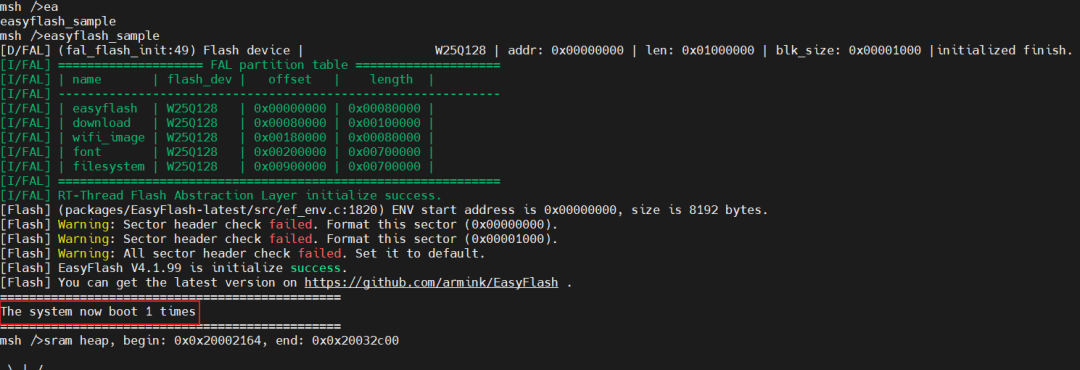
第二次RESET開發(fā)板后調(diào)用:
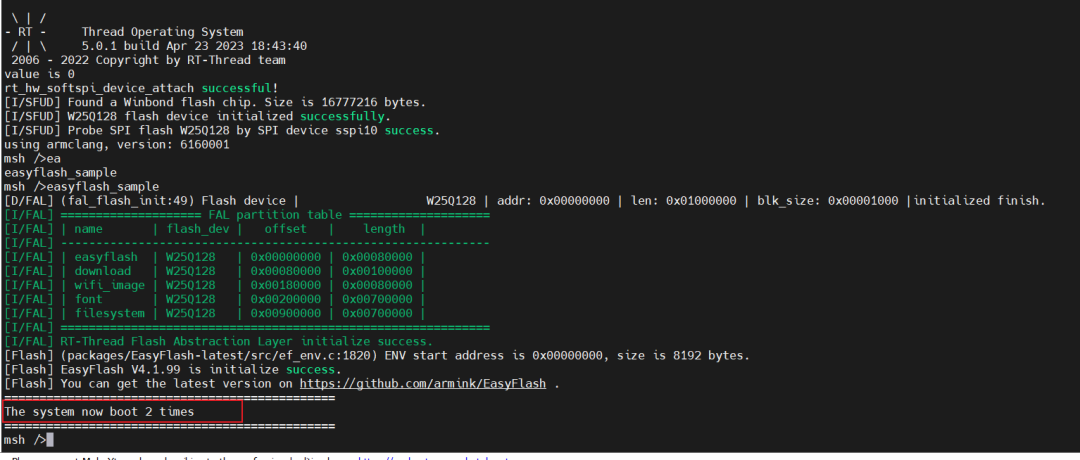
-
FlaSh
+關(guān)注
關(guān)注
10文章
1642瀏覽量
148673 -
操作系統(tǒng)
+關(guān)注
關(guān)注
37文章
6892瀏覽量
123742 -
fal
+關(guān)注
關(guān)注
0文章
5瀏覽量
6767
發(fā)布評論請先 登錄
相關(guān)推薦
FAL組件和DFS文件系統(tǒng)的功能特點和使用方法

基于FAL的EasyFlash移植
使用fal管理spiflash,編譯的程序開機時不能正常識別并報錯
基于RT-Thread的FAL分區(qū)該怎樣去配置呢
基于rt-thread studio平臺的flash使用步驟簡析
在RT-Thread Studio + Cubemx上如何實現(xiàn)對SPI FLASH的邏輯分區(qū)呢
關(guān)于【easyflash 】4.0.99版本使用問題請教
art-pi在rt-thread studio中添加easyflash的步驟
有沒有辦法提高easyflash讀取變量的速度呢
基于Flash分區(qū)進行管理的FAL Flash抽象層介紹
基于RT-Thread的EasyFlash移植參考示例
為什么使用FAL+EasyFlash往片上flash寫入數(shù)據(jù)時會出錯呢?
怎么解決littlefs掛載第二個分區(qū)失敗的問題呢?
嵌入式Linux環(huán)境變量分區(qū)制作

【LPC55S69】使用FAL分區(qū)管理與easyflash變量管理(下集)





 使用FAL分區(qū)管理與easyflash變量管理
使用FAL分區(qū)管理與easyflash變量管理










評論